
With thousands of animals that call it home, Florida is teeming with life thanks to its diverse and unique habitats. Florida is particularly well known for its stunning beaches, and its warm coastal waters are a popular attraction for swimmers and divers. Just like on the land, there are numerous animals lurking in the water, although not every one of them is friendly! In fact, you might want to be aware of some of the most dangerous animals in Florida’s oceans. Let’s find out which they are!
1. Moray Eel

Moray eels can be extremely vicious if they are disturbed.
©Rich Carey/Shutterstock.com
We’ll begin with moray eels which are a family of eels consisting of around 200 species that are found worldwide. The appearance of these eels can vary depending on the species, but many are brightly colored and can reach lengths of up to five feet. Several species of moray eels can be found in the Florida Panhandle region, particularly in the shallow inshore areas. Morays have incredibly sharp teeth and can be extremely vicious if they are disturbed. They often shelter underneath rocks and on corals and can pose a threat to divers.
2. Blue-Ringed Octopus
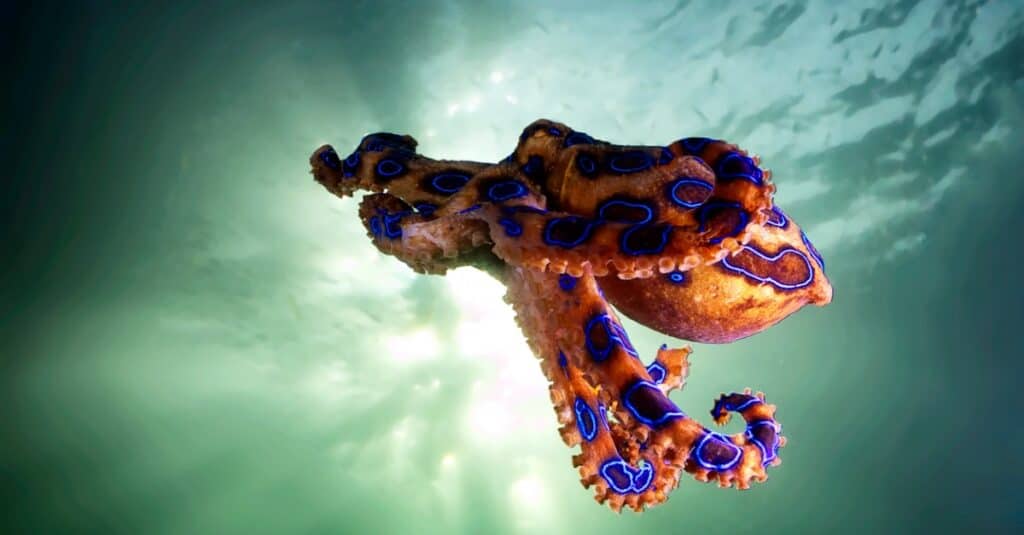
The blue ringed octopus is small but deadly, with enough venom to kill 26 humans.
©iStock.com/Subaqueosshutterbug
The next dangerous animal in Florida is the tiny, yet deadly blue-ringed octopus. Blue-ringed octopuses are only five to eight inches long and are yellowish-colored skin and striking blue and black rings. However, they are often well camouflaged and only show their rings when they are threatened or distressed. They typically hide in rocky crevices and can squeeze into tiny spaces. They prey on fish and crustaceans, injecting venom into them which paralyzes them. However, despite their tiny size, blue-ringed octopuses possess enough venom to kill approximately 26 humans. Their venom is incredibly fast-acting and death can occur within minutes following respiratory distress and heart failure.
3. Box Jellyfish

Box
jellyfish
have tentacles that contain potent toxins.
©IMC11/Shutterstock.com
The box jellyfish is one of the most dangerous animals in the world. There are more than 50 species and they are characterized by their box-shaped bell. Most species have a diameter of less than 12 inches, although their tentacles can reach more than 10 feet long. Box jellyfish live in warm coastal waters around the world, including Florida. They produce extremely painful stings and contain potent toxins which can affect the heart and nervous system, often resulting in death.
4. Great White Shark
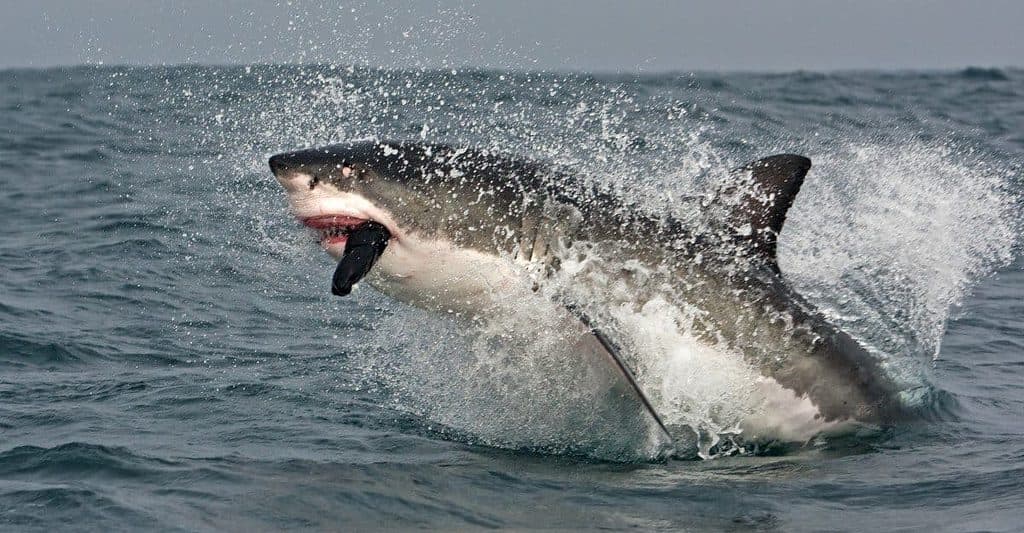
Great white sharks are responsible for a high number of shark attacks around the world.
©Martin Prochazkacz/Shutterstock.com
Another dangerous animal in Florida’s oceans is the infamous great white shark. Although they are not as common as some of the the other species of sharks that inhabit Florida’s oceans, great white sharks are definitely still around, as evidenced by recent sightings of large individuals. Great whites can reach 20 feet long and exceed 2,500 pounds, although on average they are typically smaller. They inhabit both coastal and offshore waters around the world, although they are classed as a vulnerable species. Great whites have a fearsome reputation because of the high number of shark attacks which are attributed to them, including many which were unprovoked.
5. Stingray
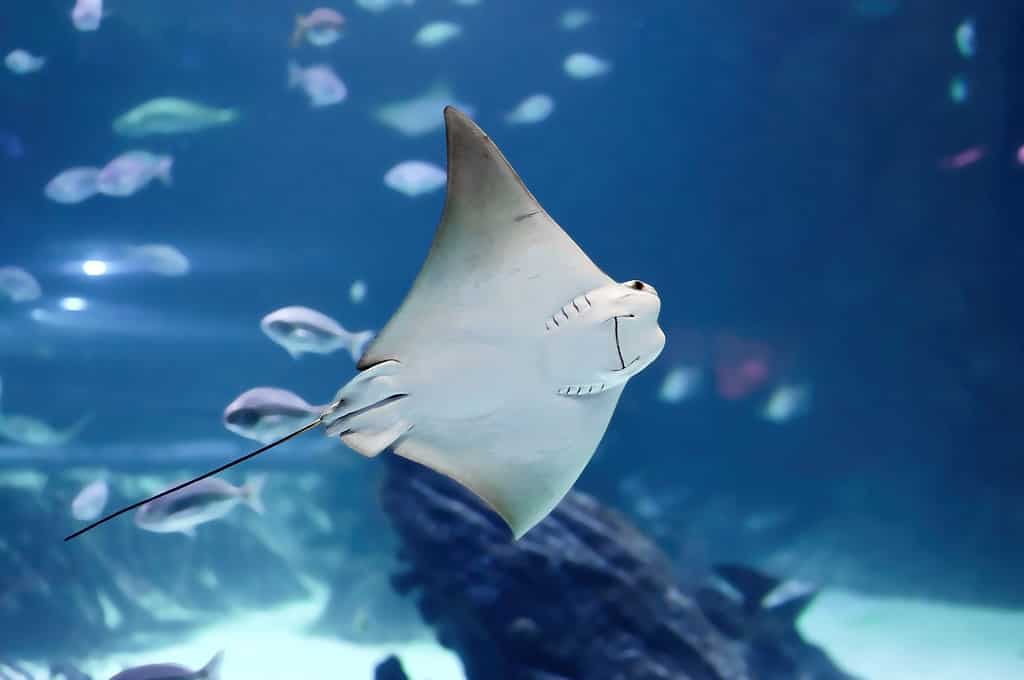
Stingrays have a long, sharp barb on the end of their tail.
©BlackFarm/Shutterstock.com
There are five species of stingrays which inhabit the waters around Florida and they are particularly common between April and October. Stingrays are bottom-dwellers and can often be found partially buried in the sand. They are recognizable by their flat, disc-shaped bodies and long tails with a venomous barb on the end. Their size varies depending on the species, but many have a disc-width that exceeds six feet. Although stingrays are not naturally aggressive, they can be defensive if they are threatened and may lash out with their tail.
6. Lionfish

There are two species of lionfish that live in Florida and both are venomous.
©Greens and Blues/Shutterstock.com
Next, we have lionfish which are classified as an invasive species in Florida. Although there are 12 species of lionfish in total, only two of them are found in Florida — red lionfish and devil firefish. They typically reach 12 to 18 inches long, with red lionfish being the larger of the two. They have a similar appearance with reddish stripes and long, venomous spines on their dorsal fins. Their venom can cause extreme pain and a burning sensation, although it is not typically fatal. Lionfish occur in the coastal waters around Florida and prey on a wide variety of other fish, including some which are approximately half of their own length.
7. Spotted Scorpion Fish
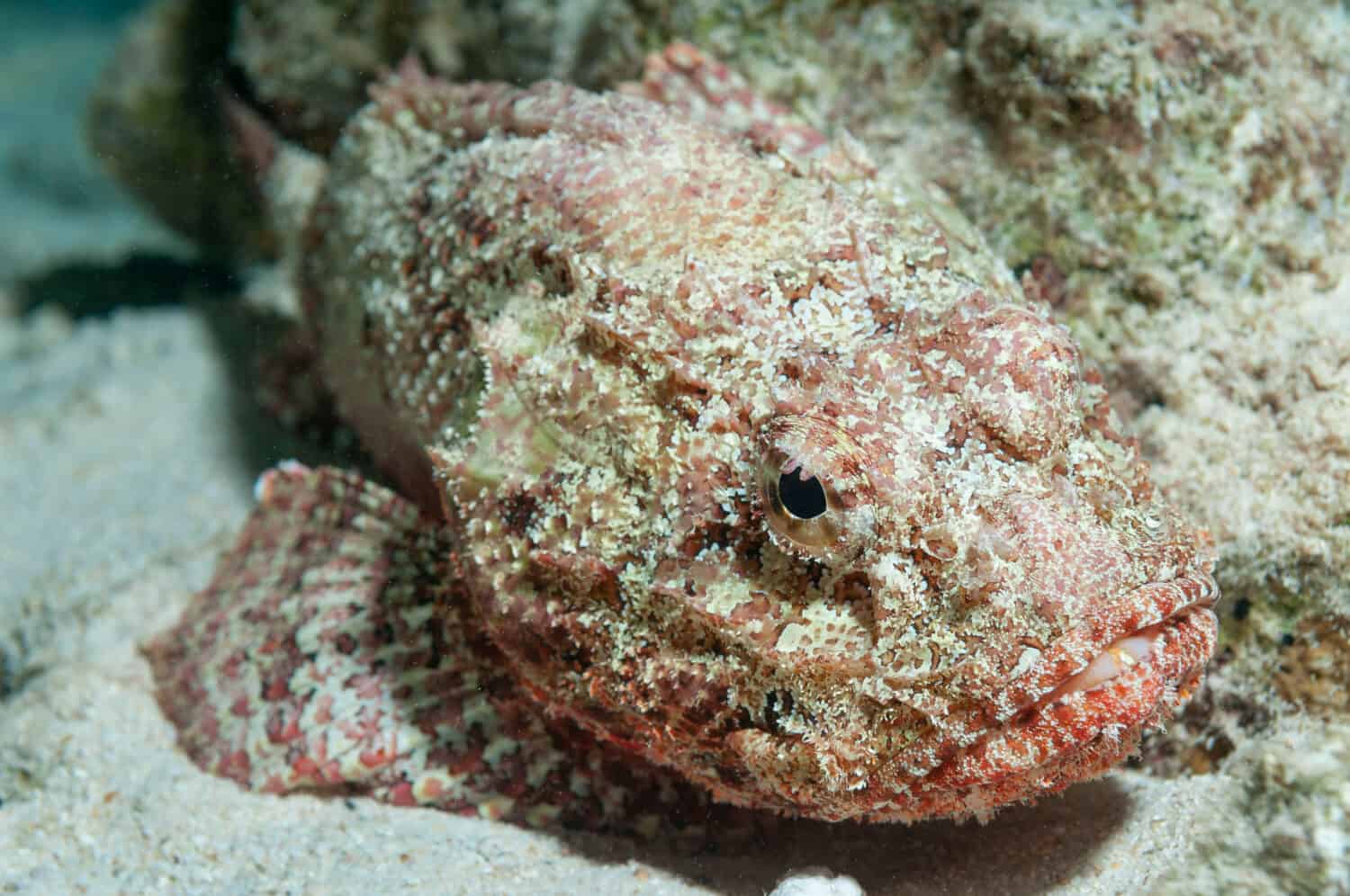
The spotted
scorpion
fish inhabit coral reefs and rocky areas.
©Jesus Cobaleda/Shutterstock.com
Spotted scorpion fish (Scorpaena plumieri) are another dangerous animal in Florida’s oceans. These reef-dwelling fish are approximately seven to 14 inches long and have distinctive colorful markings on their fins. They also have approximately 12 venomous spines on their dorsal fin. These spines release their venom when they penetrate the skin, so they typically pose a threat if they are handled or stepped on. Although not usually fatal, the venom from them can be extremely painful and medical treatment should be sought. Spotted scorpion fish prey on small fish and crustaceans which they suck into their mouth. They can typically be found around coral reefs and in shallow, rocky areas.
8. Bull Shark
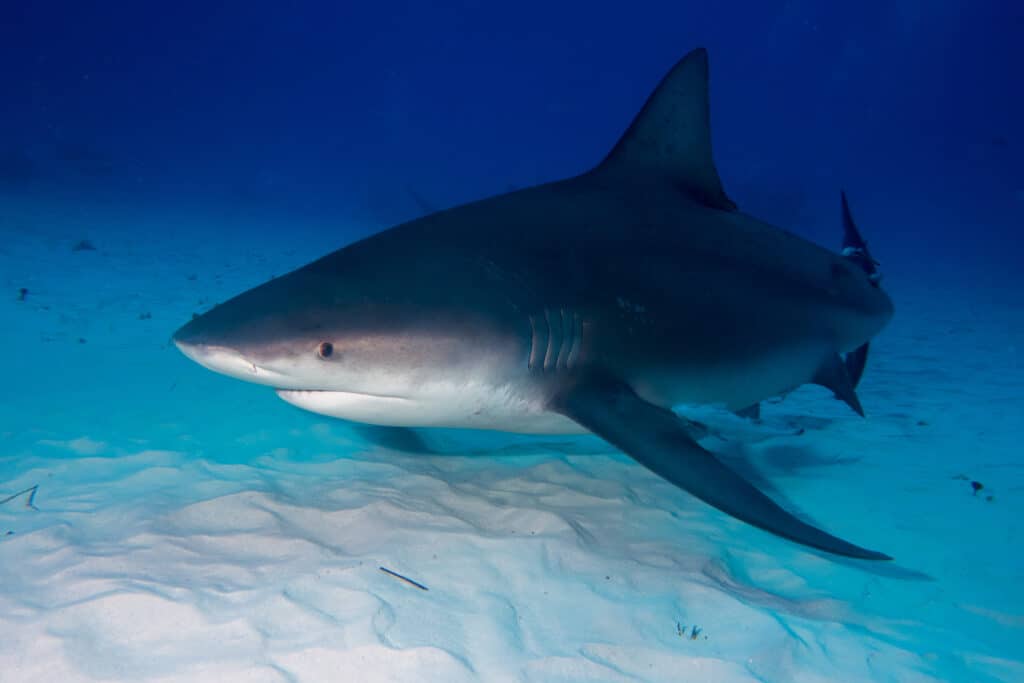
Bull sharks are large apex predators with an aggressive nature.
©HakBak/Shutterstock.com
The second shark on the list is the bull shark which doesn’t live exclusively in oceans. That’s right, bull sharks are known for their ability to tolerate freshwater, allowing them to swim for miles upriver. In fact, the lake in the center of Carbrook Golf Course in Queensland is home to its very own resident population of bull sharks! However, back in the oceans, bull sharks can be found in the waters off both the Gulf and Atlantic coasts. They are large requiem sharks which can reach approximately 11 feet long. They are apex predators and are known for their aggressive nature. Bull sharks are responsible for many attacks on humans, including the 1916 Jersey Shore attacks which were the inspiration for Jaws.
9. Stonefish
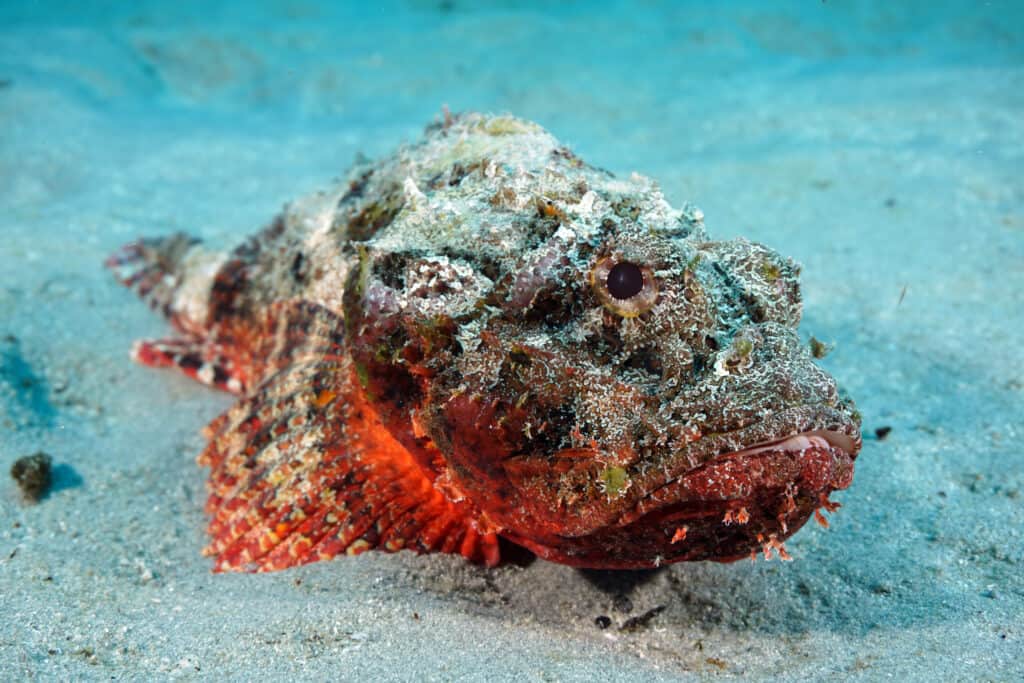
Stonefish spines contain fast-acting venom which can cause excruciating pain.
©Matt9122/Shutterstock.com
Finally, we come to stonefish which are a group of fish that, like the spotted scorpion fish, have a series of venomous spines on their dorsal fin. Stonefish are named for their grey, mottled appearance which resembles stone. They typically inhabit coral reefs or areas with muddy or rocky bottoms. Their appearance helps them to blend in with their habitat, meaning that they are often stepped on. Stonefish venom is fast-acting and causes excruciating pain and swelling. How dangerous the sting depends on the species of the fish, but in many cases it can quickly lead to death if the wound is left untreated.
Summary of the 9 Most Dangerous Animals Lurking in Florida’s Oceans
Here are the 9 Most Dangerous Animals Lurking in Florida’s Oceans:
| Rank | Animals |
|---|---|
| 1 | Moray Eel |
| 2 | Blue-Ringed Octopus |
| 3 | Box Jellyfish |
| 4 | Great White Shark |
| 5 | Stingray |
| 6 | Lionfish |
| 7 | Spotted Scorpion Fish |
| 8 | Bull Shark |
| 9 | Stonefish |
The photo featured at the top of this post is © iStock.com/Whitepointer
Thank you for reading! Have some feedback for us? Contact the AZ Animals editorial team.







